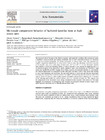Microscale compressive behavior of hydrated lamellar bone at high strain rates
Abstract
The increased risk of fracture in the elderly associated with metabolic conditions like osteoporosis poses a significant strain on health care systems worldwide. Due to bone's hierarchical nature, it is necessary to study its mechanical properties and failure mechanisms at several length scales. We conducted micropillar compression experiments on ovine cortical bone to assess the anisotropic mechanical response at the lamellar scale over a wide range of strain rates (10−4 to 8·102 s−1). At the microscale, lamellar bone exhibits a strain rate sensitivity similar to what is reported at the macroscale suggesting that it is an intrinsic property of the extracellular matrix. Significant shear band thickening was observed at high strain rates by HRSEM and STEM imaging. This is likely caused by the material's inability to accommodate the imposed deformation by propagation of thin kink bands and shear cracks at high strain rates, leading to shear band thickening and nucleation. The post-yield behavior is strain rate and direction dependent: hardening was observed for transverse oriented micropillars and hardening modulus increases with strain rate by a factor of almost 2, while axially oriented micropillars showed strain softening and an increase of the softening peak width and work to ultimate stress as a function of strain rate. This suggests that for compression at the micrometer scale, energy absorption in bone increases with strain rate. This study highlights the importance of investigating bone strength and post-yield behavior at lower length scales, under hydrated conditions and at clinically relevant strain rates.
Statement of significance
We performed micropillar compression experiments of ovine cortical bone at two different orientations and over seven orders of magnitude of strain rate. Experiments were performed under humid condition to mimic the natural conditions of bone in a human body using a newly developed micro-indenter setup. The strain rate sensitivity was found to be of a similar magnitude to what has been reported for higher length scales, suggesting that the strain rate sensitivity is an intrinsic property of the bone extracellular matrix. In addition, localized shear deformation in thick bands was observed for the first time at high strain rates, highlighting the importance of investigating bone under conditions representative of an accident or fall at several length scales. Show more
Permanent link
https://doi.org/10.3929/ethz-b-000502412Publication status
publishedExternal links
Journal / series
Acta BiomaterialiaVolume
Pages / Article No.
Publisher
ElsevierSubject
Bone; Micropillar compression; High strain rate; Strain rate sensitivity; Deformation and failure mechanismsMore
Show all metadata





